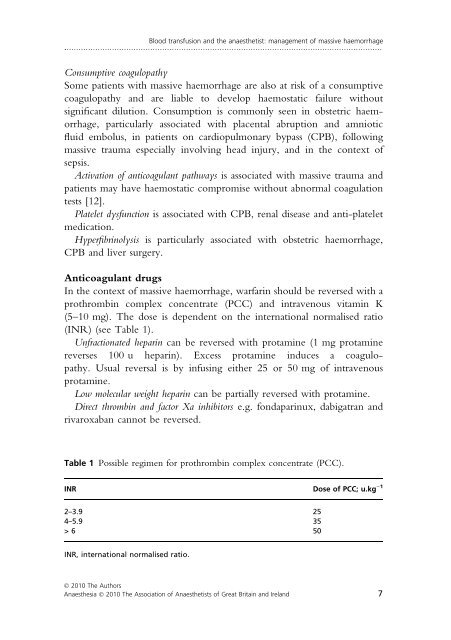Blood transfusion and the anaesthetist: management of ... - aagbi
Blood transfusion and the anaesthetist: management of ... - aagbi
Blood transfusion and the anaesthetist: management of ... - aagbi
You also want an ePaper? Increase the reach of your titles
YUMPU automatically turns print PDFs into web optimized ePapers that Google loves.
<strong>Blood</strong> <strong>transfusion</strong> <strong>and</strong> <strong>the</strong> anaes<strong>the</strong>tist: <strong>management</strong> <strong>of</strong> massive haemorrhage<br />
.....................................................................................................................................<br />
Consumptive coagulopathy<br />
Some patients with massive haemorrhage are also at risk <strong>of</strong> a consumptive<br />
coagulopathy <strong>and</strong> are liable to develop haemostatic failure without<br />
significant dilution. Consumption is commonly seen in obstetric haemorrhage,<br />
particularly associated with placental abruption <strong>and</strong> amniotic<br />
fluid embolus, in patients on cardiopulmonary bypass (CPB), following<br />
massive trauma especially involving head injury, <strong>and</strong> in <strong>the</strong> context <strong>of</strong><br />
sepsis.<br />
Activation <strong>of</strong> anticoagulant pathways is associated with massive trauma <strong>and</strong><br />
patients may have haemostatic compromise without abnormal coagulation<br />
tests [12].<br />
Platelet dysfunction is associated with CPB, renal disease <strong>and</strong> anti-platelet<br />
medication.<br />
Hyperfibrinolysis is particularly associated with obstetric haemorrhage,<br />
CPB <strong>and</strong> liver surgery.<br />
Anticoagulant drugs<br />
In <strong>the</strong> context <strong>of</strong> massive haemorrhage, warfarin should be reversed with a<br />
prothrombin complex concentrate (PCC) <strong>and</strong> intravenous vitamin K<br />
(5–10 mg). The dose is dependent on <strong>the</strong> international normalised ratio<br />
(INR) (see Table 1).<br />
Unfractionated heparin can be reversed with protamine (1 mg protamine<br />
reverses 100 u heparin). Excess protamine induces a coagulopathy.<br />
Usual reversal is by infusing ei<strong>the</strong>r 25 or 50 mg <strong>of</strong> intravenous<br />
protamine.<br />
Low molecular weight heparin can be partially reversed with protamine.<br />
Direct thrombin <strong>and</strong> factor Xa inhibitors e.g. fondaparinux, dabigatran <strong>and</strong><br />
rivaroxaban cannot be reversed.<br />
Table 1 Possible regimen for prothrombin complex concentrate (PCC).<br />
INR Dose <strong>of</strong> PCC; u.kg )1<br />
2–3.9 25<br />
4–5.9 35<br />
>6 50<br />
INR, international normalised ratio.<br />
Ó 2010 The Authors<br />
Anaes<strong>the</strong>sia Ó 2010 The Association <strong>of</strong> Anaes<strong>the</strong>tists <strong>of</strong> Great Britain <strong>and</strong> Irel<strong>and</strong> 7

















